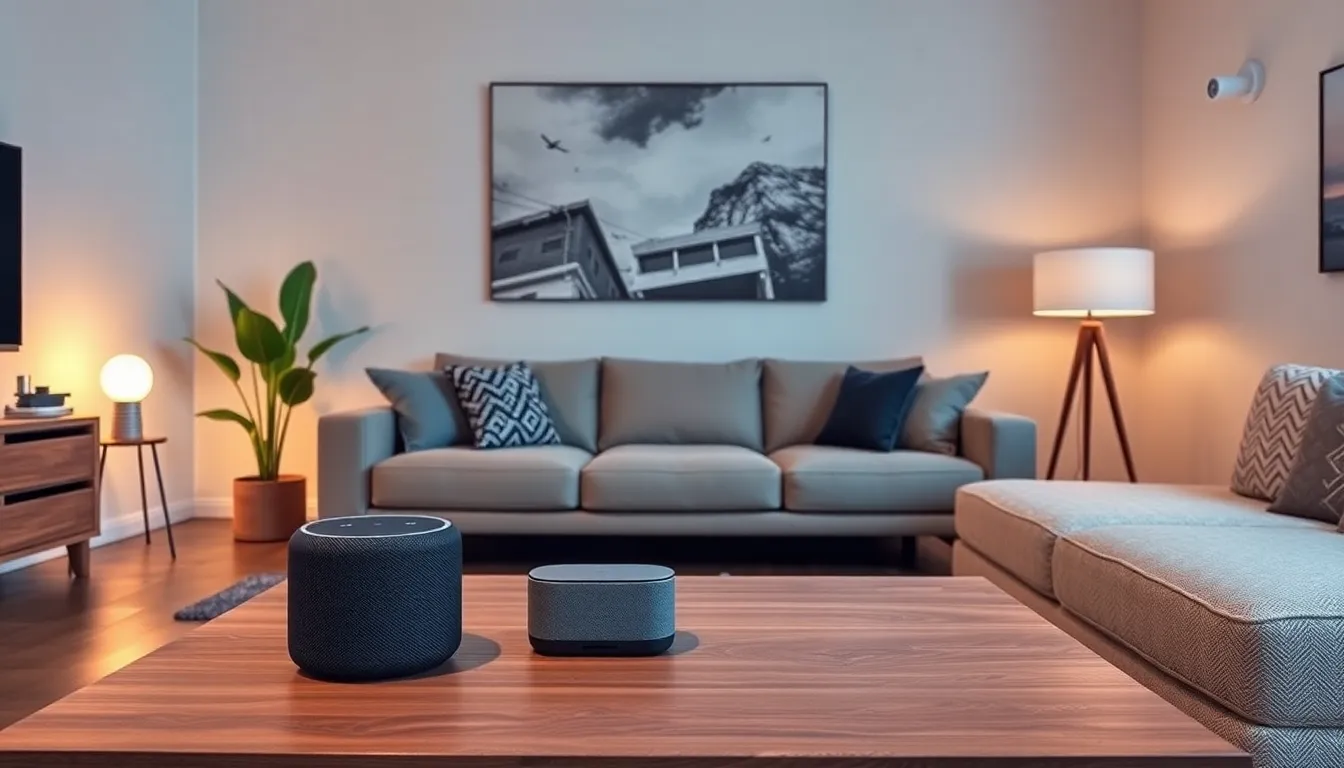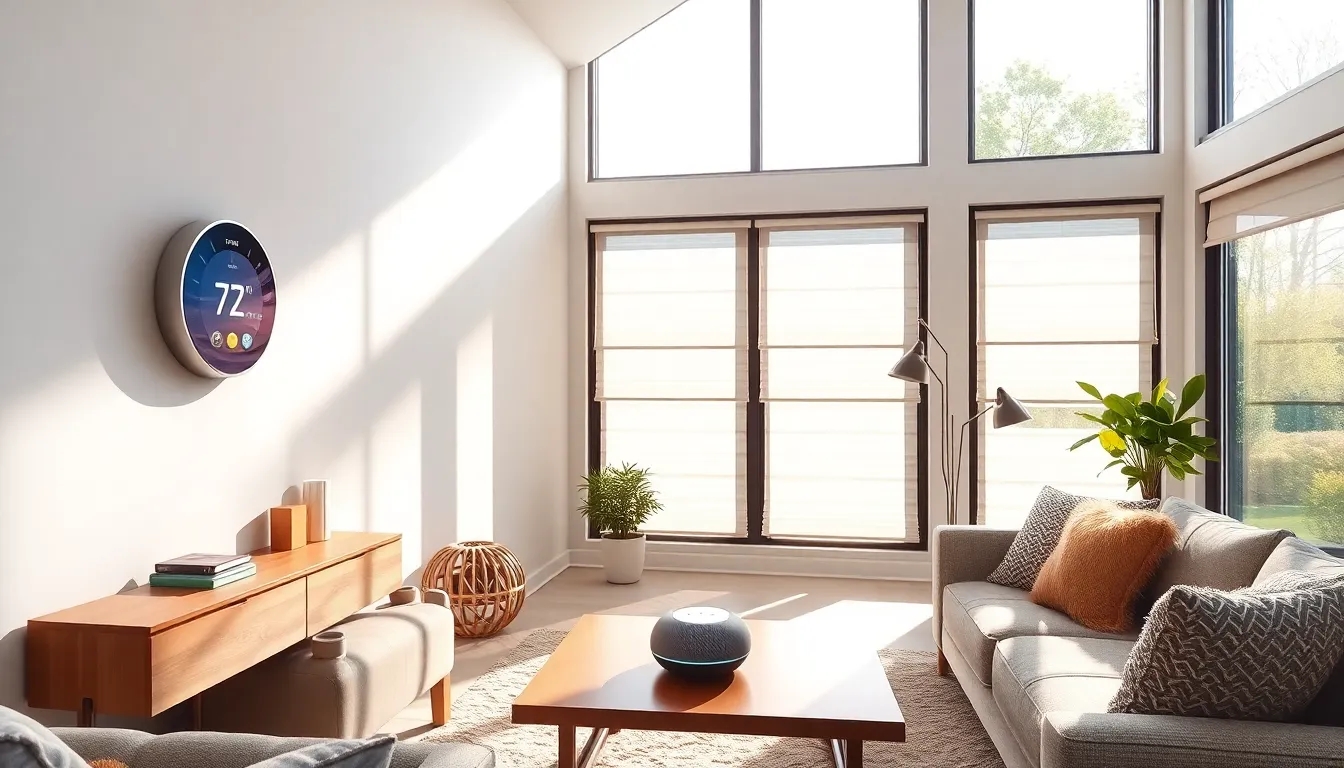Imagine walking into your home and having it greet you like a loyal puppy. Home technology systems are revolutionizing the way people experience comfort and convenience. From smart thermostats that know when you’re chilly to voice-activated assistants that can dim your lights with a mere whisper, these gadgets are not just cool—they’re essential for modern living.
Table of Contents
ToggleOverview of Home Technology Systems
Home technology systems revolutionize daily living by enhancing comfort and convenience. These systems include devices that streamline household management.
Definition of Home Technology Systems
Home technology systems, often referred to as smart home technologies, consist of interconnected devices that automate and control various functions within a home. This encompasses equipment like security cameras, smart thermostats, and smart appliances. Users interact with these devices through mobile applications or voice commands. Integration allows for seamless communication among devices, contributing to a more efficient living environment.
Importance in Modern Living
Home technology systems play a significant role in today’s households. They enhance energy efficiency, contributing to lower utility bills. Safety benefits arise from security systems that monitor properties in real-time. Additionally, these technologies promote convenience through automation, enabling users to control multiple aspects of their homes from anywhere. The increased comfort and peace of mind lead to a better quality of life for residents.
Types of Home Technology Systems

Home technology systems encompass various categories, each enhancing different aspects of modern living. Below are key types of these systems.
Smart Home Automation
Smart home automation simplifies daily routines through interconnected devices. These devices work together, allowing users to manage lighting, heating, and entertainment systems remotely. Common examples include smart speakers, which integrate with other gadgets for voice control, and smart bulbs, which can be programmed for mood settings. Advanced systems often include automated window shades, improving both convenience and energy efficiency. With user-friendly apps, he or she can monitor and control home environments from anywhere.
Security Systems
Security systems play a critical role in protecting homes and occupants. Options include smart cameras that provide real-time video feeds and motion detectors that alert users via smartphone notifications. Smart locks enhance security by allowing remote access to homes, enabling management of who enters or leaves. Many systems offer features for monitoring activity in real time, helping residents feel safer. Integration with mobile devices ensures oversight is constant and convenient, even when not at home.
Energy Management Systems
Energy management systems promote energy efficiency through smart technologies. These systems track energy consumption and allow smart thermostats to adjust heating and cooling based on occupancy patterns. Smart plugs provide insights on power usage and can automate turning off unused devices. Some energy management systems also incorporate solar energy solutions, optimizing consumption and reducing utility bills. By monitoring and managing energy use, these systems contribute to sustainability and promote cost savings for households.
Key Features to Consider
Home technology systems offer various features that enhance functionality and user experience. Consider these key aspects when selecting a system.
Compatibility and Integration
Compatibility with existing devices remains crucial. Effective home technology systems integrate seamlessly with products across brands. Many systems support various protocols such as Z-Wave, Zigbee, and Wi-Fi. Interoperability ensures that devices communicate efficiently, facilitating automation and control. Strong integration simplifies user control of smart appliances, security systems, and lighting, creating a cohesive smart home environment. Regular updates from manufacturers improve compatibility over time, so select systems with a proven track record.
User-Friendly Interfaces
User-friendly interfaces greatly enhance navigation and control. Intuitive apps and voice commands provide easy access to smart devices. A well-designed dashboard allows users to monitor and manage various functions without complication. Visual elements streamline interaction, making it simple for everyone in the household to use the technology. Voice-activated assistants further enhance accessibility, ensuring hands-free control across multiple devices. Clarity in the interface contributes to a satisfying user experience.
Scalability and Customization
Scalability allows users to expand their systems over time. A flexible system accommodates new devices, adapting to evolving needs. Customization options enhance user experiences, enabling personalization of settings for comfort and efficiency. Some systems offer tailored automation routines based on user preferences or schedules, optimizing functionality. Ensure that the chosen home technology system provides straightforward methods to add or modify devices, creating a unique smart home environment that fits individual lifestyles.
Benefits of Home Technology Systems
Home technology systems significantly enhance daily living. These systems streamline tasks, improve safety, and contribute to energy efficiency.
Convenience and Efficiency
Home technology systems optimize daily routines. Automated lighting adapts to preferences, making it easy to manage mood and ambiance. Smart speakers control music and information with simple voice commands, saving time during busy moments. Scheduling routines helps homeowners automate tasks like opening and closing blinds at specific times. Overall, the convenience offered by these technologies enhances quality of life and reduces manual effort.
Enhanced Security
Security systems fortify homes against potential threats. Smart cameras provide real-time surveillance, enabling homeowners to monitor their property remotely. Motion detectors alert residents when unusual activity occurs, ensuring timely responses. Smart locks offer secure access control and allow users to manage entry for family or guests even when away. These features create a safer home environment, contributing to peace of mind.
Energy Savings
Energy management systems track usage patterns and identify areas for improvement. Smart thermostats learn preferences and adjust settings automatically, reducing energy waste. Homeowners experience significant savings on utility bills as these technologies promote energy-efficient habits. Monitoring energy consumption through apps helps users make informed decisions about usage. Collectively, these systems lead to lower overall energy costs while supporting eco-friendly living.
Home technology systems are revolutionizing the way people live by merging convenience with efficiency. As these systems become more integrated into daily routines they not only enhance comfort but also ensure safety and sustainability. The ability to automate tasks and monitor energy usage leads to a more streamlined lifestyle while promoting eco-friendly practices.
Choosing the right system tailored to individual needs is essential for maximizing benefits. With advancements in technology continuing to emerge homeowners can look forward to even greater innovations that will further enrich their living environments. Embracing these technologies today sets the stage for a smarter and more connected tomorrow.


